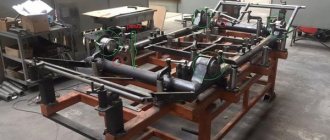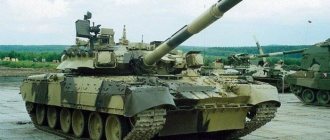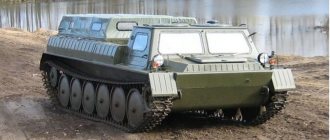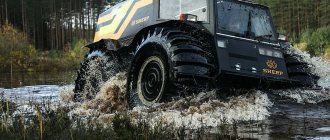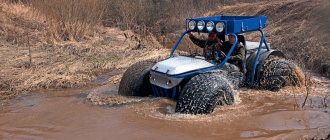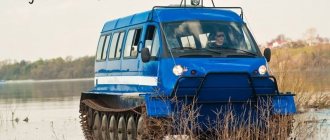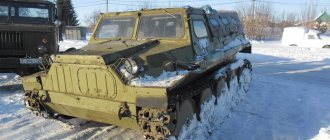In the late 2000s, a self-made designer from St. Petersburg, Alexey Garagashyan, invented an all-terrain vehicle that could drive on any roads, off-road, mud, and even cross small rivers.
in 2012, a design bureau in Kyiv began commercial production of these all-terrain vehicles. Assembly takes place in St. Petersburg.
In 2015, Sherpa was presented at the exhibition of crossovers and SUVs Moscow Off-Road Show 2015, and in February 2016, the all-terrain vehicle appears in episode 2 of the 25th season of the Top Gear auto show. After this, the Western media became interested in the car.
Now SHERP is made at factories in Kyiv and St. Petersburg.
Ukrainian all-terrain vehicles are exported all over the world, while Russian versions are used exclusively in the ranks of the Ministry of Emergency Situations.
History of creation
The talented designer, motorcycle racer and traveler Alexei Garagashyan did a lot for the Russian Sherpa. Thanks to him, the car saw the light of day. Now he is known in many countries of the world. Until this moment, the designer traveled, assembled his all-terrain vehicles. It was precisely this kind of experience that helped him assemble a truly high-quality snow and swamp-going vehicle.
The company of the same name was founded in St. Petersburg in 2012, and mass production started only in 2015. The new all-terrain vehicle Sherpa was able to pass tests in areas with absolute impassability and coped with them with dignity. The new product can easily cope with dirt, water, lack of a road, tree debris, stones, and so on. After the Moscow exhibition, the Sherp all-terrain vehicle attracted the attention of the media. In addition to the Russian press, the new product was described by such publishers as Top Gear, BBC, Daily Mail. Everyone liked her.
Features of the Sherp all-terrain vehicle
If you pay attention to the massive wheels of the domestic all-terrain vehicle, the height of which is 1.6 m, it is important to note that in addition to their visible base of the structure, they perform very important functions of the vehicle. They are tubeless, which, together with reduced pressure, leads to excessive deformation and accidental disassembly. However, to prevent this from happening, the car is equipped with special wheels and tire mounting devices.
At the same time, the wheels are practically the suspension of the new Sherpa all-terrain vehicle. When a vehicle hits a protruding obstacle, the tire, which has no rigidity, covers it, which allows you to maintain maximum grip on the surface in a similar way. As for the excess gas pressure inside the tire, it instantly begins to be distributed to other wheels using a single pneumatic system.
Since there is a centralized tire pressure monitoring system, the wheels can choose the best option for adapting to the conditions of a particular type of off-road terrain being overcome. For example, the Sherp all-terrain vehicle has the unique ability to climb from water to ice using the option of suitable tire filling.
Another important element of an all-terrain vehicle is the presence of a special rubber tread pattern. It favorably improves grip on the road surface when driving at fairly large inclination angles and overcoming obstacles. In addition to this, such a tread allows the Sherpa to move in the water only due to the rotation of the wheels. The high positive buoyancy of the vehicle is achieved by a sealed hull and a total wheel displacement of 3,400 liters.
Amphibious all-terrain vehicle
The main feature of the Sherpa is that it is able to move on water. Its swimming speed is not too fast - only 6 km/h. However, this is quite enough to overcome the ford. The machine handles well in water due to the fact that the speed of rotation of the wheels on the left and right can be adjusted using levers. This feature will greatly help tourists traveling to remote places.
As you know, it is easiest to go along rivers - there is no need to wade through the forest jungle, and the route of movement can be relatively easily measured and determined on the map, simply by looking at the river bed. However, while moving, you often have to face the fact that it is impossible to move along the bank, or you have to cross the river to the other bank. It is comfortable to travel by water transport in such places only downstream. Sherpa remains. With its help, you can either walk along the river bank or cross it without preparation. And even if the all-terrain vehicle is carried away by the current, the driver always has the opportunity to correct his position in the water and get to the desired point.
Through swamps and ice
Of course, what interests fishermen and hunters most is the ability to drive an all-terrain vehicle through wetlands. We can say with confidence that he is able to go where even a person cannot go. Its pressure on the ground can be eased by lowering the tires, and it will easily pass through the swaying quagmire. He will do the same on thin ice - a thickness of 4-5 cm is enough for his movement. Many swamps in winter do not freeze at all due to biological processes, and it will be impossible to pass there without a Sherpa.
This all-terrain vehicle is capable of not only swimming in an ice hole, but also getting out of it. By adjusting the torque on the wheels, their pumping, and rotation speed, you can climb onto thin ice without breaking it. If this fails, you can simply break it down to the area where it is thicker and accomplish your plan. A real mini icebreaker!
The author of the article loves to go pike fishing in winter. This happens in one swamp. In summer the banks are muddy and it is very difficult to get to the water. But in winter it freezes, and you can catch good pike on the balancer and girders. You can fish on such an all-terrain vehicle both in winter and summer. The places there are very quiet, secluded, and relaxation is a pleasure. Happy owners of such a car can afford it at any time of the year.
Specifications
Power unit
As we will see later, the characteristics of the Sherpa all-terrain vehicle stand out for their practicality. The car has a Japanese diesel 4-cylinder turbocharged 1.5-liter KubotaV1505-t engine. It generates 44.3 horsepower and meets the 2012 Tier 4 environmental standards. As for the power plant itself, it is very unpretentious and quite reliable.
Based on the reviews of the owners, it has enough power, despite the small power, as it may seem at first. The engine produces good torque. Regardless of any road conditions, the vehicle does not move so fast, but confidently moves forward.
Transmission
The Sherpa all-terrain vehicle has a 5-speed manual gearbox, as well as all-wheel drive. The car does not have a transfer case in order to simplify its design as much as possible. It turns out that torque is transmitted to the wheels directly through a powerful chain. The design also boasts a clutch from leading German company SACHS.
Chassis
You can control the SUV using two pedals, responsible for the gas and clutch. In addition, domestic experts have provided two levers. It turns out that Sherp turns not with the help of steering rods, but thanks to the locking of the wheels on one side. Using a similar system, it was possible to increase its maneuverability and even allow it to turn while standing still. As for the transmission levers and handbrake themselves, they were placed between the seats of the driver of the all-terrain vehicle and the passenger sitting next to it. The all-terrain vehicle boasts a hydraulic ventilated braking system.
Controls
Speaking of the dashboard, it is located at the driver’s seat and has modern equipment used on boats and gliders. Separately, it is worth highlighting the good visibility while moving, which was facilitated by the installation of wide windows around the entire perimeter of the body and a massive rear-view mirror.
All-terrain vehicle "Sherp"
Special equipment with high cross-country ability is of great interest not only for the military and security forces, but also for civilian structures, tourists, etc. Such machines allow you to get into remote corners that are inaccessible to other equipment. Manufacturers of special equipment try to respond to such wishes of potential customers and from time to time introduce new developments in this area. It is noteworthy that in addition to recognized leaders with new developments, new companies founded by enthusiasts are entering the market. An excellent example of this is the Sherp all-terrain vehicle, developed by engineer Alexey Garagashyan. A. Garagashyan is widely known among fans of snow and swamp-going vehicles. Over the past few years, this specialist has proposed several projects for vehicles with high cross-country ability. In addition, one of these developments - the Sherp all-terrain vehicle - has even reached full-fledged mass production and is being produced to order from various clients. Thanks to its characteristic appearance and high performance, this machine attracts the attention of specialists and lovers of special equipment, and also from time to time becomes the topic of publications in the press. Thus, at the beginning of February, the high characteristics of the Sherpa car were noted by the team of authors of the Top Gear project.
The Sherp project is based on experience in operating various all-terrain vehicles and several original ideas. The author of the project applied solutions already proven in this area, and also borrowed some ideas from other classes of equipment. Finally, original proposals were also used. This combination of existing and new ideas, as demonstrated by demonstration materials, has made it possible to provide the vehicle with uniquely high mobility characteristics on rough terrain and water. In terms of cross-country ability, the Sherp can be compared with tracked vehicles, and in some cases even surpasses them.
The main means of achieving high performance is the original wheeled chassis. In one of his interviews, A. Garagashyan noted that the all-terrain vehicle, first of all, consists of wheels, and the engine, transmission, etc. - just minor elements. Based on this logic, the author of the Sherp project used wheels with large, ultra-low pressure tires. Large wheels give the Sherp all-terrain vehicle a characteristic appearance, and also affect the layout of other units. Another curious feature of the chassis is the lack of suspension in the usual form.
The main element of the all-terrain vehicle's chassis is four wheels with tubeless ultra-low pressure tires. To ensure the required characteristics, the tires have a size of 1600x200-25. When creating the required wheels, it was necessary to solve several critical issues related to the interaction of the wheel rim and tire. Ultra-low pressure tires have a characteristic disadvantage: when deformed, they can come apart, for which additional fastening means must be used. For use on the Sherpa all-terrain vehicle, new rims were developed to ensure proper tire retention. In addition, their design eliminates the adhesion of dirt or ice freezing.
According to reports, in the early stages of the project, the builders of the all-terrain vehicle had to face some problems regarding the design of the available tires. To use it on the Sherpa, we had to independently modify the tread of the existing tires, cutting off unnecessary elements and making new indentations. The modified tires were rigidly mounted on the rims, without the possibility of quick dismantling.
To ensure the required wheel characteristics, a tire inflation system is used. Maintaining the required pressure is carried out by supplying exhaust gases and is carried out centrally. When starting the engine, it takes about 15 seconds to initially inflate the wheels to operating pressure. By changing the pressure in the wheels, you can change their characteristics and change the vehicle's maneuverability accordingly.
Front of the car
Unlike many other all-terrain vehicles, the Sherpa does not have suspension in the generally accepted sense. The axles of all four wheels are rigidly attached to the body and are not able to move in a vertical plane. Instead of a mechanical suspension, an original system was used, which A. Garagashyan called pneumocirculatory. All four wheels are connected by a common pneumatic system responsible for inflation. Such lines are made of pipes of relatively large diameter, which ensures the free movement of gases from one tire to another. When a wheel hits an obstacle, the tire is deformed, the pressure in it increases, but the gases are redistributed over the remaining wheels.
The main advantage of the so-called pneumatic circulation suspension is to maintain contact with the surface when driving on different routes. So, when hitting an obstacle, the wheel literally covers it and maintains normal contact, rather than hanging the car. However, such a system is not without drawbacks. Soft running is provided only at low and medium speeds. When accelerating to high speed, the pneumatic circulation system cannot dampen all the vibration caused by an uneven surface.
The use of large wheels, as well as their role as the main element of the machine, affected the design of other units. The all-terrain vehicle "Sherp" received a box-shaped body, consisting of straight surfaces and inscribed in the space between the wheels. The front part of the body, housing the driver's cabin, is formed by an inclined frontal part consisting of several elements, as well as diverging sides. A cargo platform is provided behind the cabin to accommodate passengers or other payload. Above the wheels on the sides there are curved wings connected to each other by jumpers. All main components of the body are made of steel.
Dimensions of the all-terrain vehicle
The engine and main transmission elements are located in the central part of the body. The basis of the power plant is the Kubota V1505-t diesel engine with a power of 44.3 hp. The engine is connected to a five-speed manual transmission. As conceived by the author of the project, the Sherpa transmission is responsible not only for transmitting torque to the wheels, but also for controlling the car. To do this, in early versions of the project, a differential from a KamAZ truck was connected to the gearbox, from which two side shafts emerged. The latter were equipped with ventilated brake discs, as well as chain drive gears. The differential shafts and wheel axles were connected using chains. The possibility of using other systems was also considered. On serial all-terrain vehicles, rotation mechanisms of our own design are installed, based on friction clutches.
To control the machine, it is proposed to use the gas and clutch pedals, the gearbox lever, as well as two levers connected to the hydraulic drives of the onboard brakes. Thus, the vehicle is turned “tank-style” - by braking the wheels of one side. This allows the all-terrain vehicle to turn almost on the spot, but is associated with some power losses due to heating of individual elements, and also imposes certain restrictions on driving the vehicle.
The body of the Sherpa all-terrain vehicle is divided into two main parts. The front compartment provides two seats for the driver and passenger. Serial all-terrain vehicles are equipped with car-type seats with seat belts. In this case, the seats are mounted on the front of the engine casing. Between the seats are the handbrake and gearbox control levers. At the driver's workplace there are two pedals and two levers, as well as a set of control devices and other controls.
Due to the impossibility of using side doors, Sherp received other means for boarding the cabin. The windshield of the car is installed in a hinged frame. To enter the car, the window must be raised. In addition, it can be held in this position while moving. Opposite the passenger seat, a folding ramp door is provided in the frontal sheet of the body. For added convenience, there is a tubular footrest at the bottom of the frontal part of the body. The side windows of the cabin are also made in the form of lifting blocks and can be fixed in any desired position.
The rear cargo area is made in the form of a compartment with the ability to install seats or other equipment designed to transport a payload. Access to the cargo compartment is through a hinged door. It should be noted that the lower part of the cargo compartment, related to the body, is unified and is used in both modifications of the all-terrain vehicle. The upper equipment, in turn, is different.
In the “Standard” configuration, the “Sherp” all-terrain vehicle receives several arches and a textile awning. For a comfortable stay in the cabin, the car also receives a liquid heater. There is also a KUNG modification, characterized by the use of a rigid metal insulated van. Inside such a body there is a soft interior with the ability to change the configuration. In particular, tourists have the opportunity to spend the night in the right place, using a bed measuring about 2100x1100 mm. The total volume of the passenger compartment is 3 cubic meters.
The dry weight of the Sherp all-terrain vehicle is only 1300 kg. The length of the car is 3.4 m, width – 2.5 m, height – 2.3 m. Ground clearance depends on tire pressure and can reach 600 mm. The normal load capacity of the machine is determined at 500 kg. With such a load, the all-terrain vehicle can move on various surfaces without a significant reduction in cross-country ability. Due to some reduction in such characteristics, the mass of the cargo can be increased to 1000 kg. It is possible to tow a trailer weighing up to 2.4 tons.
Overcoming obstacles
The engine used allows the car to accelerate to 45 km/h on good roads. When towing a trailer, the maximum speed drops to 30-33 km/h, but in this case the maneuverability is significantly reduced. The sealed body allows the machine to overcome water obstacles by swimming. By turning the wheels, the speed on the water reaches 6 km/h. In the basic configuration, the Sherpa is equipped with a 58-liter fuel tank. At the customer's request, four additional tanks with a capacity of 50 liters can be mounted in the wheel rims.
The all-terrain vehicle can move on various surfaces, including those with low load-bearing capacity, swim and overcome various obstacles. Thus, the stated possibility of climbing a wall up to 1 m high and overcoming a 35-degree slope. The developers are especially proud of the machine’s “ability” to rise from water to ice. Due to the special configuration of the chassis, the all-terrain vehicle is able to exit the water not only along the slopes of the shore, but also in other difficult conditions.
The low weight of the vehicle, combined with ultra-low pressure tires and low specific load, also provide the all-terrain vehicle with fairly high maneuverability. Under the control of an experienced driver, the car is capable of turning almost on the spot, making sharp turns or entering a controlled skid. Maneuverability, maneuverability and the ability to swim give the Sherpa very high mobility on various landscapes.
All-terrain vehicle on a transport cart
To date, the Sherp all-terrain vehicle has passed the entire range of tests and reached mass production. Cars are built to order from certain customers. Potential customers are offered two main configurations of the vehicle, differing in the type of cargo compartment. In addition, some additional options are offered. For an additional fee, the all-terrain vehicle can be equipped with an independent air heater, a 60A generator, 90-watt diode headlights, additional fuel tanks, etc. A special trailer for transporting an all-terrain vehicle is also offered, which is a single-axle cart with a towing device.
In the “Standard” configuration, the all-terrain vehicle will cost the customer 3.85 million rubles. Due to the different body, the KUNG version costs 250 thousand more. Additional systems installed at the request of the customer also affect the cost of the finished machine. For example, an additional tank for a wheel will cost 13 thousand rubles, and for a trailer you will have to pay an additional 268.8 thousand.
To date, a fairly large number of Sherpa all-terrain vehicles have been built, which are actively used by various customers. In addition to buyers, the development team also uses this technique. From time to time, A. Garagashyan and his colleagues organize hikes in different regions of the country, during which they overcome difficult routes using equipment of their own construction. To confirm the high characteristics of the Sherpas, videos taken during campaigns are regularly published.
Not long ago, the Sherp all-terrain vehicle became of interest to foreign specialists, which led to the appearance of a real wave of publications in the foreign and domestic press. In just a couple of days, an interesting project gained fame not only among a narrow circle of fans of snow and swamp-going vehicles, but also among the general public. It is quite possible that these publications in the media will become a kind of advertising and will affect the number of new orders, and will also, to one degree or another, help the further development of the project.
Based on materials from the sites: https://garagashyan.ru/ https://sherp.ru/ https://popmech.ru/ https://uazbuka.ru/ https://topgear.com/ https://ria. ru/ https://lunohodov.net/
Abundance of modifications
Russian Sherp is produced in some modifications:
- Sherpa Standard. This option has a soft awning, wheel caps, ultra-resistant polymer body paint, three batteries, halogen optics, as well as heat and noise insulation for the engine compartment.
- Sherpa Kung. This version boasts a hard kung that can transform, when necessary, into a warm, soft interior. Thanks to the use of a rigid kung, the best thermal insulation of the Sherp's interior is ensured.
- Sherp Pro. A restyled version with a lightweight aluminum body. In this situation, the body is painted in a rather aggressive color.
- Sherp PICKUP. This is a modification of the Sherpa all-terrain vehicle, which has a pickup-type body layout.
In addition to this, the manufacturing company has something else to offer potential buyers. There are also additional options for the car, which are purchased as a separate option. This list boasts:
- Trailer for transporting “Sherpa” over long distances;
- Four additional fuel tanks, which are placed in the wheels;
- Generator 60A;
- LED lighting kit.
Equipment and prices
Despite the fact that the design of the all-terrain vehicle itself is quite simple, it does not have a lot of complex or expensive parts, it costs a lot - about $100,000. This is the price of a good apartment in the suburbs of Moscow or a good cottage in a village there. Therefore, it is not available to everyone. Many say that this is precisely the purpose of the high price - so that only a select few would own it and be able to show it off to others.
There are two models of this all-terrain vehicle - Sherpa and Sherpa-pickup.
For an all-terrain vehicle, you can buy a car trailer on which it can be easily transported by attaching it to the towbar of a car, a transportable trailer for the all-terrain vehicle itself, a drag that can serve as both a boat and a trailer, various spare parts kits and many other things. Sherpa differs from Sherpa-pickup in that the first has a monolithic body, the second has a removable rear part of the cabin. As a result, it can be used to transport oversized cargo that does not fit into the cabin through the door.
Where can I buy and price?
To pre-order the purchase of Sherp, you must use the official website of the manufacturer. The company has provided a leasing system for legal entity buyers. In our country, the dealer network can be found only in the Irkutsk, Murmansk, Tver, Tyumen regions, and Khanty-Mansi Autonomous Okrug and Yakutia. In addition, there are representatives and authorized dealers in countries such as Ukraine, Kazakhstan, the United States of America, and Canada.
The price of the Sherpa all-terrain vehicle has recently increased significantly. Previously, you could buy a Sherpa all-terrain vehicle from 3,850,000 to 4,100,000 rubles. However, now you can purchase a model in the Sherp PRO version for no less than RUB 5,500,000. The basic version of Sherpa MAX will cost at least 6,500,000 rubles.
Market: analogues and competitors
Initially, the all-terrain vehicle was conceived as a very reliable, durable and not the most expensive model, accessible not only to the elite. We can say that the designer succeeded. Sherpa can be easily transported without the use of special equipment to the place of operation; most other all-terrain vehicles will have to be towed on a heavy trailer using a truck or tractor. It is convenient and affordable for a city dweller. True, the price of the all-terrain vehicle itself looks somewhat overpriced if you evaluate the cost of its layout.
You can name a number of other all-terrain vehicles, which are much more difficult to manufacture and more expensive in cost, but they are cheaper on the market than the Sherpa. For example, “Forester”, “Junta”, “Husky”. All of them have the main difference from Sherpa - they are controlled using a standard car steering wheel. Such a system, of course, is more familiar to the average driver than tractor control. However, it has many disadvantages - it is more complex to manufacture, the turning radius is larger, and the driver has fewer options when passing difficult areas.
It must be admitted that when driving on bare asphalt, such cars will have slightly less tread wear. And the maximum speed of the same “Junta” is better - up to 70. However, you have to pay for this with worse cross-country ability. Still, when a person buys an amphibious all-terrain vehicle, he rather wants to drive everywhere than just drive fast. There's a car for that. Today, Sherp has no serious competitors in its class; it is produced in Russia and Ukraine, and is also sold abroad to Canada. Its high price can be considered not as a payment for the production of an all-terrain vehicle, but as a payment for the original idea and concept that allowed it to do what it can do.
Advantages and disadvantages
Pros of the car
- Excellent maneuverability;
- High maneuverability;
- Quite a high speed of movement;
- Smooth ride;
- Possibility of free exit from the water to the shore or ice surface;
- Wheels that prevent the adhesion of dirt, snow and ice;
- High reliability of the design;
- Convenient access to main technical units;
- Volumetric internal space that can accommodate up to 4-6 people;
- A successful climate control system that can provide effective heating and ventilation.
Cons of the car
- Short engine life (maintenance required every 50 operating hours);
- There are no side doors in the front compartment;
- Poor reliability of circuits;
- Price;
- Repair cost.
